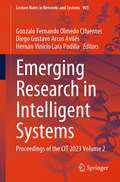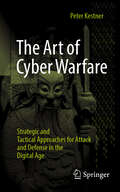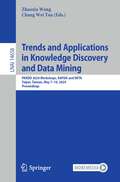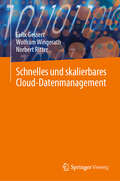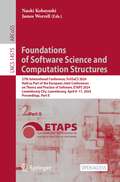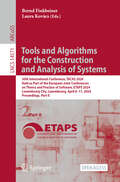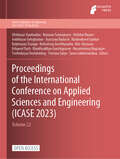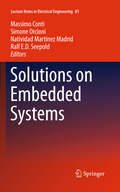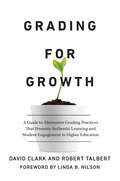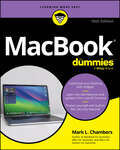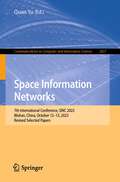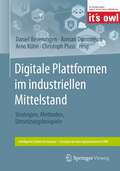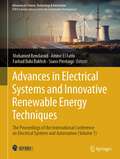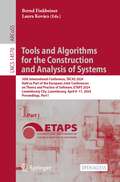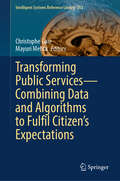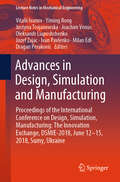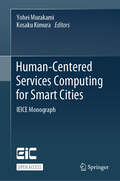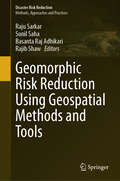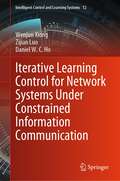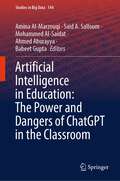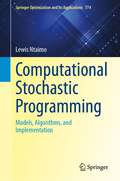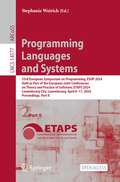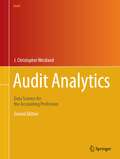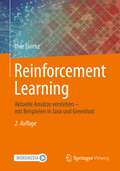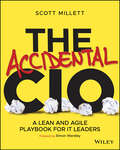- Table View
- List View
Emerging Research in Intelligent Systems: Proceedings of the CIT 2023 Volume 2 (Lecture Notes in Networks and Systems #903)
by Gonzalo Fernando Olmedo Cifuentes Diego Gustavo Arcos Avilés Hernán Vinicio Lara PadillaThis book covers different aspects of advances in research, technological development, and innovation results in artificial intelligence, computational modeling, electrical, electronics, telecommunication, data communications, defense engineering, innovation, technology and society, managing technology and sustained innovation, business development, security and cryptography, and software engineering. In addition, the volume focuses on research results focused on finding innovative solutions in intelligent systems concerning the topics mentioned above, which are developed in national and international postgraduate programs and associated research groups and networks. This book interests the industry, teachers, undergraduate and graduate students, and researchers working in intelligent systems, security and defense, and technological, human, and administrative sciences.
The Art of Cyber Warfare: Strategic and Tactical Approaches for Attack and Defense in the Digital Age
by Peter KestnerThe Art of Cyber Warfare explores the strategic and tactical approaches for offense and defense in the digital age. Drawing on historical conflicts from Sun Tzu to Carl von Clausewitz, the author illustrates that, despite changed conditions such as time, location, means, and resources – but not the laws of physics – it is possible to learn from past actions and reactions.The author aims to demonstrate in this book that, in reality, we have only transferred old methods into our current era but have forgotten to translate their reasons, effects, and the resulting lessons. For, as it has been for thousands of years, the reasons for human-created conflicts remain the same: wealth, fame, power, honor, or desire. Can we learn something from history for present and future (cyber) wars?
Trends and Applications in Knowledge Discovery and Data Mining: PAKDD 2024 Workshops, RAFDA and IWTA, Taipei, Taiwan, May 7–10, 2024, Proceedings (Lecture Notes in Computer Science #14658)
by Zhaoxia Wang Chang Wei TanThis book constitutes the workshops that have been held in conjunction with the 27th Pacific-Asia Conference on Knowledge Discovery and Data Mining, PAKDD 2023, which took place in Osaka, Japan, during May 25–28, 2023. For RAFDA 2024, Workshop on Research and Applications of Foundation Models for Data Mining and Affective Computing, 15 submissions have been received and 9 full papers have been accepted for publication. For IWTA 2024, International Workshop on Temporal Analytics, 4 full papers have been accepted from a total of 6 submissions.
Schnelles und skalierbares Cloud-Datenmanagement
by Felix Gessert Wolfram Wingerath Norbert RitterDie enorme Datenmenge erfordert skalierbare Datenverwaltung für weltweiten Zugriff. Zahlreiche NoSQL-Systeme prägen die komplexe Landschaft. Dieses Buch bietet Überblick und Klassifikation im Cloud-Datenmanagement. Themen umfassen NoSQL-Speichersysteme, polyglotte Architekturen, verteilte Transaktionen, Web-Caching, Datenzugriff und Rendering-Performance. Die Klassifikation ermöglicht eine Betrachtung des Gesamtentwurfs und der Positionen jedes Systems. Ein anwendungsorientiertes Entscheidungshilfetool erleichtert die Auswahl geeigneter Systemkandidaten für bestimmte Anwendungsszenarien.
Foundations of Software Science and Computation Structures: 27th International Conference, FoSSaCS 2024, Held as Part of the European Joint Conferences on Theory and Practice of Software, ETAPS 2024, Luxembourg City, Luxembourg, April 6–11, 2024, Proceedings, Part II (Lecture Notes in Computer Science #14575)
by Naoki Kobayashi James WorrellThe two open access volumes LNCS 14574 and 14575 constitute the proceedings of the 27th International Conference on Foundations of Software Science and Computation Structures, FOSSACS 2024, which took place in Luxembourg in April 2024.The 24 full papers included in this book were carefully reviewed and selected from 79 submissions. They were organized in topical sections as follows: Part I: Infinite games; categorical semantics; automata and synthesis; Part II: Types and programming languages; logic and proofs; infinite-state systems.
Tools and Algorithms for the Construction and Analysis of Systems: 30th International Conference, TACAS 2024, Held as Part of the European Joint Conferences on Theory and Practice of Software, ETAPS 2024, Luxembourg City, Luxembourg, April 6–11, 2024, Proceedings, Part II (Lecture Notes in Computer Science #14571)
by Bernd Finkbeiner Laura KovácsThe open access book 3-volume set LNCS 14570-14573 constitutes the proceedings of the 30th International Conference on Tools and Algorithms for the Construction and Analysis of Systems, TACAS 2024, which was held as part of the European Joint Conferences on Theory and Practice of Software, ETAPS 2024, during April 6-11, 2024, in Luxembourg.The 53 full papers and 16 short SVComp contributions included in these proceedings were carefully reviewed and selected from 159 submissions. They were organized in topical sections as follows:Part I: STA and SMT solving; synthesis; logic and decidability; program analysis and proofs; proof checking; Part II: Model Checking; automata and learning; software verification; probabilistic systems; simulations; Part III: Neural networks; testing and verification; games; concurrency; SV-Comp 2024.
Proceedings of the International Conference on Applied Sciences and Engineering (Atlantis Highlights in Engineering #22)
This is an open access book.We kindly welcome to all academicians, researchers, scientists, engineers and graduate students in the related fields to submit their original research papers. Applications in engineering science that require expertise in mathematics, physics and chemistry. Its mission is to become a voice of the applied science community, addressing researchers and practitioners in different areas ranging from mathematics, physics, and chemistry to all related braches of the engineering, presenting verifiable computational methods, findings, and solutions.The Conference provided a setting for discussing recent developments in various engineering and applied science topics, including Mathematics, Chemistry, Physics, Computational science, Material science, Environmental Science and Chemical engineering.The submitted conference papers will be subjected to stringent peer review and carefully evaluated based on originality and clarity of exposition. All the accepted papers will be published in the conference proceedings. The conference provides opportunities for the attendants to share new ideas, experiences in Applied Sciences and Engineering and to establish collaboration for the future.
Solutions on Embedded Systems (Lecture Notes in Electrical Engineering #81)
by Massimo Conti Simone Orcioni Natividad Martínez Madrid Ralf E.D. SeepoldEmbedded systems have an increasing importance in our everyday lives. The growing complexity of embedded systems and the emerging trend to interconnections between them lead to new challenges. Intelligent solutions are necessary to overcome these challenges and to provide reliable and secure systems to the customer under a strict time and financial budget.Solutions on Embedded Systems documents results of several innovative approaches that provide intelligent solutions in embedded systems. The objective is to present mature approaches, to provide detailed information on the implementation and to discuss the results obtained.
Grading for Growth: A Guide to Alternative Grading Practices that Promote Authentic Learning and Student Engagement in Higher Education
by David Clark Robert TalbertAre you satisfied with your current and traditional grading system? Does it accurately reflect your students’ learning and progress? Can it be gamed? Does it lead to grade-grubbing and friction with your students?The authors of this book – two professors of mathematics with input from colleagues across disciplines and institutions – offer readers a fundamentally more effective and authentic approach to grading that they have implemented for over a decade.Recognizing that traditional grading penalizes students in the learning process by depriving them of the formative feedback that is fundamental to improvement, the authors offer alternative strategies that encourage revision and growth.Alternative grading is concerned with students’ eventual level of understanding. This leads to big changes: Students take time to review past failures and learn from them. Conversations shift from “why did I lose a point for this” to productive discussions of content and process.Alternative grading can be used successfully at any level, in any situation, and any discipline, in classes that range from seminars to large multi-section lectures. This book offers a comprehensive introduction to alternative grading, beginning with a framework and rationale for implementation and evidence of its effectiveness. The heart of the book includes detailed examples – including variations on Standards-Based Grading, Specifications Grading, and ungrading -- of how alternative grading practices are used in all kinds of classroom environments, disciplines and institutions with a focus on first-hand accounts by faculty who share their practices and experience. The book includes a workbook chapter that takes readers through a step-by-step process for building a prototype of their own alternatively graded class and ends with concrete, practical, time-tested advice for new practitioners.The underlying principles of alternative grading involve·Evaluating student work using clearly defined and context-appropriate content standards.·Giving students helpful, actionable feedback.·Summarizing the feedback with marks that indicate progress rather than arbitrary numbers.·Allowing students to revise without penalty, using the feedback they receive, until the standards are met or exceeded.This book is intended for faculty interested in exploring alternative forms of learning assessment as well as those currently using alternative grading systems who are looking for ideas and options to refine practice.
MacBook For Dummies
by Mark L. ChambersDiscover the best tips and tricks for using your new Mac laptop For years, MacBook For Dummies has been making it easy to learn new technology. This new edition keeps the easy-to-follow instructions coming. Learn the basics of customizing your Dock and using desktop widgets. Then, figure out how to go on the internet, stream music, send instant messages, and more. Expert author Mark Chambers will show you how to navigate the macOS operating system and personalize your MacBook to your liking. And you'll learn your way around features like Stage Manager, Continuity Camera, SharePlay, and Handoff. Is this your first new computer in a while? MacBook For Dummies gives you the rundown on how to exist without an internal DVD drive. Whether you're a newbie or a Mac veteran looking for insider tips, this is the quick start guide for you. Learn the features and productivity tools from macOS Stay protected by making the most of the built-in Mac security features Organize your life with Mac's multitasking feature, Stage Manager Discover how to stream music, edit videos, and share media content online MacBook beginners and upgraders alike will graduate to power users of the MacBook Pro and MacBook Air models, thanks to this trusted Dummies title.
Space Information Networks: 7th International Conference, SINC 2023, Wuhan, China, October 12–13, 2023, Revised Selected Papers (Communications in Computer and Information Science #2057)
by Quan YuThis book constitutes revised selected papers from the thoroughly refereed proceedings of the 7th International Conference on Space Information Network, SINC 2023, held in Wuhan, China, during October 12–13, 2023. The 8 full papers and 5 short papers included in this book were carefully reviewed and selected from 73 submissions. The papers present the latest research in the fields of space information networks.
Digitale Plattformen im industriellen Mittelstand: Strategien, Methoden, Umsetzungsbeispiele (Intelligente Technische Systeme – Lösungen aus dem Spitzencluster it’s OWL)
by Daniel Beverungen Roman Dumitrescu Arno Kühn Christoph PlassDieses Buch stellt neue Strategien, Methoden und Umsetzungsbeispiele vor, mit denen digitale Plattformen zur Realisierung erfolgreicher Geschäftsstrategien im industriellen Mittelstand eingesetzt werden. Digitale Plattformen sind Erfolgsgaranten für viele Weltmarktführer im Konsumgüterbereich. Aber auch der industrielle Mittelstand kann mit ihrer Hilfe neue Geschäftsfelder erschließen und Wettbewerbsvorteile realisieren. In diesem Band zeigen wir auf, warum sich produzierende Unternehmen schon heute in diesem Wettbewerbsumfeld positionieren müssen und welche strategischen Handlungsoptionen existieren. Ein strukturierter Transformationspfad zeigt, wie der industrielle Mittelstand über die Etablierung digitaler Dienstleistungen den Sprung in die Plattformökonomie schaffen kann. Innovative Methoden und Werkzeuge bieten konkrete Hilfestellung, um diesen Transformationsprozess strategisch zu planen und umzusetzen. Zwei ausgewählte Praxisbeispiele zeigen schließlich auf, wie der Einstieg in die Plattformökonomie erfolgreich gelingt.
Advances in Electrical Systems and Innovative Renewable Energy Techniques: The Proceedings of the International Conference on Electrical Systems and Automation (Volume 1) (Advances in Science, Technology & Innovation)
by Mohamed Bendaoud Amine El Fathi Farhad Ilahi Bakhsh Siano PierluigiThis edited book on “Advances in Electrical Systems and Innovative Renewable Energy Techniques” is an outcome of the selected papers presented at the International Conference on Electrical Systems & Automation, (ICESA 2023) held from 29 to 30, May 2023 at the Faculty of Sciences and technologies, Al Hoceïma, Morocco.This edited book is divided into 2 volumes. This volume will be divided into 3 parts, each devoted to distinct yet interconnected aspects of the subject matter.The first part focuses on various advancements in renewable energy techniques. It explores topics ranging from biomass combustion characteristics and hydrogen production using photovoltaics to the assessment of wave energy potential and the performance evaluation of solar collectors. These research papers not only shed light on the current state-of-the-art technologies but also offer valuable insights into their implementation, efficiency, and potential impact on the energy landscape.The second part focuses on interdisciplinary approaches between electrical and renewable energy systems and includes research chapters on photovoltaic (PV) energy, wind energy, and microgrid systems.For PV systems, several topics and issues are addressed such as modeling of PV systems using single diode model and double diode model; analytical and numerical methods for extraction of PV parameters; extraction of maximum power from PV system using integral SMC strategy, sun-pointing orientation, SuDoKu, and ANN algorithms; and fault detection and classification based on metaheuristic technique, and feedforward neural network.For the wind system, its modeling is first discussed, and then the control of the wind system using direct power, PI, fuzzy logic, sliding mode, and time delay strategies is analyzed.In the third part, the chapters focus on efficient energy management, optimization of microgrids, and the use of advancedtechnologies to improve energy performance. Researchers present innovative solutions to address the challenges of energy efficiency, grid responsiveness, and the integration of new energy sources.
Tools and Algorithms for the Construction and Analysis of Systems: 30th International Conference, TACAS 2024, Held as Part of the European Joint Conferences on Theory and Practice of Software, ETAPS 2024, Luxembourg City, Luxembourg, April 6–11, 2024, Proceedings, Part I (Lecture Notes in Computer Science #14570)
by Bernd Finkbeiner Laura KovácsThe open access book 3-volume set LNCS 14570-14573 constitutes the proceedings of the 30th International Conference on Tools and Algorithms for the Construction and Analysis of Systems, TACAS 2024, which was held as part of the European Joint Conferences on Theory and Practice of Software, ETAPS 2024, during April 6-11, 2024, in Luxembourg.The 53 full papers and 16 short SVComp contributions included in these proceedings were carefully reviewed and selected from 159 submissions. They were organized in topical sections as follows:Part I: STA and SMT solving; synthesis; logic and decidability; program analysis and proofs; proof checking; Part II: Model Checking; automata and learning; software verification; probabilistic systems; simulations; Part III: Neural networks; testing and verification; games; concurrency; SV-Comp 2024.
Transforming Public Services—Combining Data and Algorithms to Fulfil Citizen’s Expectations (Intelligent Systems Reference Library #252)
by Christophe Gaie Mayuri MehtaThis book provides a precise portrayal of the current trends and future perspectives of e-Government. It outlines new approaches that optimize public services across diverse sectors. Going beyond traditional boundaries, it offers mathematical models for public services supported by convincing case studies. This book significantly enhances various government services, such as education, healthcare, safety, security, and culture. It also strongly emphasizes safeguarding citizens' personal data, ensuring privacy, and obtaining explicit consent. Tailored for students and academics, the book is an invaluable reference for teaching graduate courses in e-Government, Process Modelling, or Artificial Intelligence. Its impact extends beyond the classroom; civil servants from all domains can find practical insights to navigate the ongoing modernization of public services. Even citizens curious about the transformation in their public services can find this book enlightening. Researchers working in the area of e-Governance can use this book to discover the recent developments in e-Government.
Advances in Design, Simulation and Manufacturing: Proceedings of the International Conference on Design, Simulation, Manufacturing: The Innovation Exchange, DSMIE-2018, June 12-15, 2018, Sumy, Ukraine (Lecture Notes in Mechanical Engineering)
by Vitalii Ivanov Yiming Rong Justyna Trojanowska Joachim Venus Oleksandr Liaposhchenko Jozef Zajac Ivan Pavlenko Milan Edl Dragan PerakovicThis book reports on topics at the interface between manufacturing, mechanical and chemical engineering. It gives a special emphasis to CAD/CAE systems, information management systems, advanced numerical simulation methods and computational modeling techniques, and their use in product design, industrial process optimization and in the study of the properties of solids, structures and fluids. Control theory, ICT for engineering education as well as ecological design and food technologies are also among the topics discussed in the book. Based on the International Conference on Design, Simulation, Manufacturing: The Innovation Exchange (DSMIE-2018), held on June 12-15, 2018, in Sumy, Ukraine, the book provides academics and professionals with a timely overview and extensive information on trends and technologies behind current and future developments of Industry 4.0, innovative design and renewable energy generation.
Human-Centered Services Computing for Smart Cities: IEICE Monograph
by Yohei Murakami Kosaku KimuraThis open-access book compiles seven monographs from researchers at the forefront of services computing and artificial intelligence for smart cities. This is structured into three thematic parts: service composition, big data analysis, and service integration for smart cities.The first part describes service compositions for smart cities, where interaction between services and the physical world, including humans, is paramount, unlike services on the Web and clouds. The second part addresses the challenges of big data analytics in smart cities, with a focus on privacy-preserving methodologies. The third part reports human-centered service integration for applications in smart cities.
Geomorphic Risk Reduction Using Geospatial Methods and Tools (Disaster Risk Reduction)
by Raju Sarkar Sunil Saha Basanta Raj Adhikari Rajib ShawThis book explores the use of advanced geospatial techniques in geomorphic hazards modelling and risk reduction. It also compares the accuracy of traditional statistical methods and advanced machine learning methods and addresses the different ways to reduce the impact of geomorphic hazards.In recent years with the development of human infrastructures, geomorphic hazards are gradually increasing, which include landslides, flood and soil erosion, among others. They cause huge loss of human property and lives. Especially in mountainous, coastal, arid and semi-arid regions, these natural hazards are the main barriers for economic development. Furthermore, human pressure and specific human actions such as deforestation, inappropriate land use and farming have increased the danger of natural disasters and degraded the natural environment, making it more difficult for environmental planners and policymakers to develop appropriate long-term sustainability plans. The most challenging task is to develop a sophisticated approach for continuous inspection and resolution of environmental problems for researchers and scientists. However, in the past several decades, geospatial technology has undergone dramatic advances, opening up new opportunities for handling environmental challenges in a more comprehensive manner.With the help of geographic information system (GIS) tools, high and moderate resolution remote sensing information, such as visible imaging, synthetic aperture radar, global navigation satellite systems, light detection and ranging, Quickbird, Worldview 3, LiDAR, SPOT 5, Google Earth Engine and others deliver state-of-the-art investigations in the identification of multiple natural hazards. For a thorough examination, advanced computer approaches focusing on cutting-edge data processing, machine learning and deep learning may be employed. To detect and manage various geomorphic hazards and their impact, several models with a specific emphasis on natural resources and the environment may be created.
Iterative Learning Control for Network Systems Under Constrained Information Communication (Intelligent Control and Learning Systems #12)
by Wenjun Xiong Zijian Luo Daniel W. HoThis book focuses on the subject area of Network Systems and Control Theory, providing a comprehensive examination of the dynamic behavior of networked systems operating under communication constraints. It introduces innovative iterative learning control strategies that aim to ensure stability, consistency, and security of networked systems. The field of networked systems has garnered significant interest from scientists and engineers across various disciplines, including information, electrical, transportation, life, social, and management sciences. This book consistently addresses a wide range of issues related to networked systems, emphasizing the critical impact of communication constraints on stability and security. It highlights the effectiveness and importance of iterative learning methods in tackling these challenges.Suitable for both undergraduate and graduate students interested in networked systems and iterative learning control, this book alsoserves as a valuable resource for university faculty and engineers engaged in complex systems, control theory research, and real-world applications. Its broad appeal extends to professionals working in related fields, seeking a deeper understanding of networked systems and their control mechanisms.
Artificial Intelligence in Education: The Power and Dangers of ChatGPT in the Classroom (Studies in Big Data #144)
by Amina Al-Marzouqi Said A. Salloum Mohammed Al-Saidat Ahmed Aburayya Babeet GuptaThis book aims to bring together a collection of innovative and cutting-edge research that addresses the various challenges in the application and theoretical aspects of ChatGPT in education. ChatGPT is a large language model developed by OpenAI that has the ability to generate human-like text based on a prompt. This has significant potential for use in the field of education, as it allows for the creation of personalized, interactive learning experiences, automating assessment and grading, and more. In e-learning, ChatGPT is used to provide instant feedback and support to students, as well as generate interactive conversations in the target language for language learning. It is also integrated with existing learning management systems and educational technology platforms to enhance their capabilities. In research, ChatGPT is used for natural language processing and sentiment analysis to gather insights on student learning experiences and educational outcomes. However, it is important to note that there are also ethical and privacy concerns that come with using language models like ChatGPT in education, such as data protection and the potential for bias. Overall, the use of ChatGPT in education has the potential to revolutionize the way we learn, teach, and access information. The book seeks to publish original manuscripts that cover a broad range of topics, from the development of new chatbot technologies and their integration into the classroom, to the examination of the ethical and pedagogical implications of these systems. By compiling the latest developments in the field and highlighting new areas for exploration, this book provides valuable insights and perspectives for researchers, educators, and practitioners working in the field of ChatGPT and education. The ultimate goal is to advance the understanding of ChatGPT and its role in education and to promote its effective and responsible use in the classroom and beyond.
Computational Stochastic Programming: Models, Algorithms, and Implementation (Springer Optimization and Its Applications #774)
by Lewis NtaimoThis book provides a foundation in stochastic, linear, and mixed-integer programming algorithms with a focus on practical computer algorithm implementation. The purpose of this book is to provide a foundational and thorough treatment of the subject with a focus on models and algorithms and their computer implementation. The book’s most important features include a focus on both risk-neutral and risk-averse models, a variety of real-life example applications of stochastic programming, decomposition algorithms, detailed illustrative numerical examples of the models and algorithms, and an emphasis on computational experimentation. With a focus on both theory and implementation of the models and algorithms for solving practical optimization problems, this monograph is suitable for readers with fundamental knowledge of linear programming, elementary analysis, probability and statistics, and some computer programming background. Several examples of stochastic programming applications areincluded, providing numerical examples to illustrate the models and algorithms for both stochastic linear and mixed-integer programming, and showing the reader how to implement the models and algorithms using computer software.
Programming Languages and Systems: 33rd European Symposium on Programming, ESOP 2024, Held as Part of the European Joint Conferences on Theory and Practice of Software, ETAPS 2024, Luxembourg City, Luxembourg, April 6–11, 2024, Proceedings, Part II (Lecture Notes in Computer Science #14577)
by Stephanie WeirichThe two-volume open access book set LNCS 14576 + 14577 constitutes the proceedings of the 33rd European Symposium on Programming, ESOP 2024, which was held during April 6-11, 2024, in Luxemburg, as part of the European Joint Conferences on Theory and Practice of Software, ETAPS 2024.The 25 full papers and 1 fresh perspective paper presented in these proceedings were carefully reviewed and selected from 72 submissions. The papers were organized in topical sections as follows:Part I: Effects and modal types; bidirectional typing and session types; dependent types; Part II: Quantum programming and domain-specific languages; verification; program analysis; abstract interpretation.
Audit Analytics: Data Science for the Accounting Profession (Use R!)
by J. Christopher WestlandThis book, using R and RStudio, demonstrates how to render an audit opinion that is legally and statistically defensible; analyze, extract, and manipulate accounting data; build a risk assessment matrix to inform the conduct of a cost-effective audit program; and more. Today, information technology plays a pivotal role in financial control and audit: most financial data is now digitally recorded and dispersed among servers, clouds and networks over which the audited firm has no control. Additionally, a firm’s data—particularly in the case of finance, software, insurance and biotech firms—comprises most of the audited value of the firm. Financial audits are critical mechanisms for ensuring the integrity of information systems and the reporting of organizational finances. They help avoid the abuses that led to passage of legislation such as the Foreign Corrupt Practices Act (1977), and the Sarbanes-Oxley Act (2002). Audit effectiveness has declined over the past two decades, as auditor skillsets have failed to keep up with advances in information technology. Information and communication technology lie at the core of commerce today and are integrated in business processes around the world. This book is designed to meet the increasing need of audit professionals to understand information technology and the controls required to manage it. This 2nd edition includes updated code and test. Machine learning, AI, and SEC’s EDGAR data are also, improved and updated. The material included focuses on the requirements for annual Securities and Exchange Commission audits (10-K) for listed corporations. These represent the benchmark auditing procedures for specialized audits, such as internal, governmental, and attestation audits. Many examples reflect the focus of the 2024 CPA exam, and the data analytics-machine learning approach will be central to the AICPA’s programs, in the near future.
Reinforcement Learning: Aktuelle Ansätze verstehen – mit Beispielen in Java und Greenfoot
by Uwe LorenzIn uralten Spielen wie Schach oder Go können sich die brillantesten Spieler verbessern, indem sie die von einer Maschine produzierten Strategien studieren. Robotische Systeme üben ihre Bewegungen selbst. In Arcade Games erreichen lernfähige Agenten innerhalb weniger Stunden übermenschliches Niveau. Wie funktionieren diese spektakulären Algorithmen des bestärkenden Lernens? Mit gut verständlichen Erklärungen und übersichtlichen Beispielen in Java und Greenfoot können Sie sich die Prinzipien des bestärkenden Lernens aneignen und in eigenen intelligenten Agenten anwenden. Greenfoot (M.Kölling, King’s College London) und das Hamster-Modell (D.Bohles, Universität Oldenburg) sind einfache, aber auch mächtige didaktische Werkzeuge, die entwickelt wurden, um Grundkonzepte der Programmierung zu vermitteln. Wir werden Figuren wie den Java-Hamster zu lernfähigen Agenten machen, die eigenständig ihre Umgebung erkunden. Die zweite Auflage enthält neue Themen wie "Genetische Algorithmen" und "Künstliche Neugier" sowie Korrekturen und Überarbeitungen.
The Accidental CIO: A Lean and Agile Playbook for IT Leaders
by Scott MillettAn indispensable guide showing IT leaders the way to balance the needs of innovation and exploration with exploitation and operational reliability Many books on modern IT leadership focus solely on supporting innovation and disruption. In practice these must be balanced with the need to support waste reduction in existing processes and capabilities while keeping the foundation operational, secure, compliant with regulations, and cost effective. In The Accidental CIO, veteran software developer-turned-executive Scott Millett delivers an essential playbook to becoming an impactful, strategic leader at any stage of your IT leadership journey from your earliest aspirations to long time incumbents in director and C-suite roles. You’ll find a wealth of hands-on advice for tackling the many challenges and paradoxes that face technology leaders, from creating an aligned IT strategy, defining a target architecture, designing a balanced operating model, and leading teams and executing strategy. After the foreword from Simon Wardley, The Accidental CIO will help you: Understand problem contexts you will face using the Cynefin decision making framework, and how the philosophies of agile, lean and design thinking can help manage them. Design an adaptive and strategically aligned operating model by applying the appropriate ways of working and governance approaches depending on each unique problem context. Organize a department using a blend of holacratic and hierarchical principles, and leveraging modern approaches such as Team Topology and Socio-technical patterns. Develop and deploy an effective and aligned IT Strategy using Wardley mapping based on a deep knowledge of your business architecture. With this knowledge you’ll be ready to create an empowered IT organization focused on solving customer problems and generating enterprise value. You’ll understand the science behind what motivates teams and changes behavior. And you’ll show your skills as a business leader thinking beyond IT outputs to impactful business outcomes.
